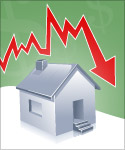In July 2024, the Household Finance landscape reveals significant insights and changes in consumer expectations that could shape financial decisions across the country. The latest Survey of Consumer Expectations conducted by the Federal Reserve Bank of New York provides a glimpse into the financial outlook of households, illustrating a mixture of resilience and concern among consumers.
Household Spending Expectations Plunge to Lowest Level Since 2021
Current Economic Climate: A Snapshot
The economic environment has been increasingly characterized by adaptive consumer behavior. As we delve into the findings from the July 2024 survey, several key indicators stand out:
- The median home price growth expectations remained steady at 3.0%, signaling stable anticipations in the housing market.
- The median expected growth in household income also held firm at 3.0%. This consistency is noteworthy, considering income growth has fluctuated slightly, ranging between 2.9% and 3.3% since January 2023.
Spending Habits and Growth Expectations
Despite the optimistic views on income and home prices, consumer expectations regarding spending have taken a subtle downward turn:
- Median household spending growth expectations fell by 0.2 percentage point to 4.9%, marking the lowest reading since April 2021. This decline suggests a cautious approach to discretionary expenditures among consumers.
Impacts on Consumer Behavior:
The reduction in spending expectations could be reflective of:
- Increased consumer caution in light of rising living costs.
- Economic uncertainty leading households to prioritize savings over spending.
Perceptions of Credit Access
One of the notable findings in this survey is the changing sentiment around credit accessibility:
- In July, consumer perceptions regarding credit access deteriorated, with a growing share of households reporting it has become harder to obtain credit compared to a year ago.
- Contrary to this decline, expectations for future credit availability improved slightly. The percentage of respondents who anticipate it will be harder to access credit in the coming year has decreased.
Financial Stability Concerns
Financial stability remains a critical issue, highlighted by perceptions of debt management:
- The average perceived probability of missing a minimum debt payment over the next three months increased by 1.0 percentage point to 13.3%. This figure represents the highest reading since April 2020 and underscores the economic pressures faced, particularly among lower-income households.
Demographics at Risk:
The increase in payment default perceptions mostly affects:
- Households with an annual income below $50,000.
- Individuals holding a high school degree or less, who often face more financial strain amid rising costs.
Tax Expectations and Government Debt
Tax burden expectations shifted slightly:
- The median expectation regarding a year-ahead change in taxes decreased by 0.3 percentage points to 4.0%. This change might signal an awareness of potential tax policy adjustments aimed at alleviating some of the financial strain imposed on households.
- On government debt, the median year-ahead expected growth remained unchanged at 9.3%. A stable outlook on government debt indicates that consumers are unlikely to see drastic changes affecting their financial strategies related to taxes and public services in the near term.
Interest Rates and Savings Outlook
Attitudes toward savings and interest rates also showed signs of fluctuation:
- The mean perceived probability that the average interest rate on savings accounts will be higher in 12 months decreased by 0.2 percentage points to 25.1%. This shift may suggest consumer skepticism about favorable interest rates in the near future.
Comparative Financial Situations: Current vs. Future
Interestingly, while perceptions of current financial situations have improved slightly, expectations for the year ahead have not mirrored this sentiment:
- Households reported a slight increase in confidence regarding their current financial situations compared to last year.
- However, expectations for future financial situations declined, with more households anticipating a worse financial state in one year.
Market Insights: Stock Prices and Economic Optimism
The survey also sheds light on consumer optimism surrounding investments:
- The mean perceived probability that U.S. stock prices will be higher in 12 months saw a slight increase, ticking up 0.1 percentage point to 39.3%. This modest rise reflects a general sense of cautious optimism among investors.
Summary: Navigating Through Changes in Household Finance
The July 2024 Survey of Consumer Expectations highlights a complex interplay of optimism and caution among U.S. households. With steady expectations in income and home price growth juxtaposed against rising concerns over spending and credit access, consumers are navigating a delicate balance.
As households adjust their financial strategies in response to these insights, it becomes clear that while some economic indicators remain stable, underlying concerns about financial stability and affordability will continue to influence consumer behavior in the months ahead.
Encouragingly, the resilience displayed by many households suggests they are adapting to these changes, positioning themselves to weather potential economic storms.
For further detailed insights, you can refer to the Federal Reserve Bank of New York’s July 2024 Survey of Consumer Expectations.
ALSO READ:
- Mixed Signals in US Economy: New Forecast Predicts Slower Growth
- How Strong is the US Economy Today in 2024?
- Economic Forecast: Will Economy See Brighter Days in 2024?
- Will the Economy Recover in 2024?
- Is the US Economy Going to Crash: Economic Outlook
- How Close Are We to Total Economic Collapse?
- Is the US Economy Going to Crash: Economic Outlook
- Economic Forecast for Next 10 Years




